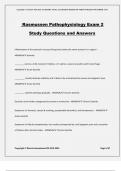Copyright © KAYLIN 2024/2025 ACADEMIC YEAR. ALL RIGHTS RESERVED FIRST PUBLISH NOVEMBER, 2024
Rasmussen Pathophysiology Exam 2
Study Questions and Answers
Inflammation of the stomach's mucosal lining (may involve the entire stomach or a region) -
ANSWER✔✔-Gastritis
_________Can be a mild, transient irritation, or it cab be a severe ulceration with hemorrhage -
ANSWER✔✔-Acute Gastritis
_________ Usually develops suddenly and is likely to be accompanied by nausea and epigastric pain -
ANSWER✔✔-Acute Gastritis
_________ Gastritis develops gradually. - ANSWER✔✔-Chronic Gastritis
Gastritis can be further categorized as erosive or nonerosive - ANSWER✔✔-Chronic Gastritis
Symptoms of: Anorexia, nausea & vomiting, postprandial discomfort, and hematemesis. - ANSWER✔✔-
Acute Gastritis
Symptoms of: May be asymptomatic, but usually accompanied by a dull epigastric pain and a sensation
of fullness after minimal intake. - ANSWER✔✔-Chronic Gastritis
Copyright © Stuvia International BV 2010-2024 Page 1/34
, Copyright © KAYLIN 2024/2025 ACADEMIC YEAR. ALL RIGHTS RESERVED FIRST PUBLISH NOVEMBER, 2024
Inflammation of the stomach and intestines, usually because of an infection or allergic reaction -
ANSWER✔✔-Gastroenteritis
Usually due to primary inflammatory disease such as crohns disease - ANSWER✔✔-Chronic
Gastroenteritis
Commonly due to direct infection such as salmonella from raw or undercooked chicken or eggs -
ANSWER✔✔-Acute Gastroenteritis
Signs & Symptoms: Diarrhea, abdominal discomfort, pain, nausea, and vomiting - ANSWER✔✔-
Gastroenteritis
Most common cause of chronic gastritis - ANSWER✔✔-Helicobacter pylori
Embeds itself in the mucous layer, activating toxins and enzymes that cause inflammation. Genetic
vulnerability and lifestyle behaviors (smoking and stress) may increase the susceptibility - ANSWER✔✔-
Helicobacter pylori
Other causes of?: Organisms transmitted though food and water contamination, long-term use of
nonsteroidal anti-inflammatory drugs, excessive alcohol use, severe stress, autoimmune conditions, and
other chronic disease - ANSWER✔✔-Gastritis
Complications of?: Peptic ulcers, gastric cancer, and hemorrhage - ANSWER✔✔-Chronic Gastritis
Copyright © Stuvia International BV 2010-2024 Page 2/34
, Copyright © KAYLIN 2024/2025 ACADEMIC YEAR. ALL RIGHTS RESERVED FIRST PUBLISH NOVEMBER, 2024
Manifestations of?: Include indigestion, heartburn, epigastric pain, abdominal cramping, nausea,
vomiting, anorexia, fever, and malaise. Hematemesis and dark, tarry stools can indicate ulceration and
bleeding. - ANSWER✔✔-Gastritis
Chyme periodically backs up from the stomach into the esophagus. Bile can also back up into the
esophagus. - ANSWER✔✔-GERD (Gastroesophageal Reflux Disease)
These gastric secretions irritate the esophageal mucosa - ANSWER✔✔-GERD (Gastroesophageal Reflux
Disease)
Causes of?: certain foods (e.g., chocolate, caffeine, carbonated beverages, citrus fruit, tomatoes, spicy or
fatty foods, and peppermint), alcohol consumption, nicotine, hiatal hernia, obesity, pregnancy, certain
medications (e.g., corticosteroids, beta blockers, calcium-channel blockers, and anticholinergics),
nasogastric intubation, and delayed gastric emptying - ANSWER✔✔-GERD (Gastroesophageal Reflux
Disease)
Manifestations of?: heartburn, epigastric pain (usually after a meal or when recombinant), dysphagia,
dry cough, laryngitis, pharyngitis, regurgitation of food, and sensation of a lump in the throat. -
ANSWER✔✔-GERD (Gastroesophageal Reflux Disease)
Complications of?: esophagitis, strictures, ulcerations, esophageal cancer, and chronic pulmonary
disease - ANSWER✔✔-GERD (Gastroesophageal Reflux Disease)
Often confused with angina and may warrant ruling out cardiac disease - ANSWER✔✔-GERD
(Gastroesophageal Reflux Disease)
Copyright © Stuvia International BV 2010-2024 Page 3/34
, Copyright © KAYLIN 2024/2025 ACADEMIC YEAR. ALL RIGHTS RESERVED FIRST PUBLISH NOVEMBER, 2024
Lesions affecting the lining of the stomach or duodenum - ANSWER✔✔-Peptic Ulcer Disease (PUD)
Risk factors of?: being male, advancing age, nonsteroidal anti-inflammatory drug use (NSAIDs), H. pylori
infections, certain gastric tumors, and those for GERD. - ANSWER✔✔-Peptic Ulcer Disease (PUD)
Vary in severity from superficial erosions to complete penetration through the GI tract wall. Develops
because of an imbalance between destructive forces and protective mechanisms - ANSWER✔✔-Peptic
Ulcer Disease (PUD)
Types of Peptic Ulcer Disease (PUD) - ANSWER✔✔-Duodenal Ulcers
Gastric Ulcers
Stress Ulcers
Most commonly associated with excessive acid or H. pylori infections. Typically present with epigastric
pain that is relieved in the presence of food - ANSWER✔✔-Duodenal ulcers
Less frequent but more deadly. Typically associated with malignancy and nonsteroidal anti-inflammatory
drugs. Pain typically worsens with eating. - ANSWER✔✔-Gastric Ulcers
Develop because of a major physiological stressor on the body due to local tissue ischemia, tissue
acidosis, bile salts entering the stomach, and decreased GI motility. - ANSWER✔✔-Stress ulcers
Stress ulcers associated with burns - ANSWER✔✔-Curling's ulcers
Stress ulcers associated with head injuries - ANSWER✔✔-Cushing's ulcers
Copyright © Stuvia International BV 2010-2024 Page 4/34




